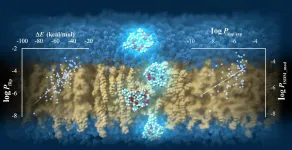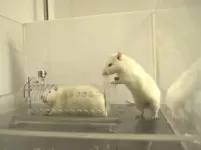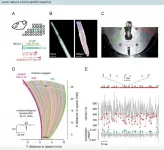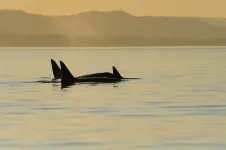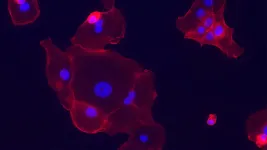Mathematical model predicts the movement of microplastics in the ocean
A new model tracking the vertical movement of algae-covered microplastic particles offers hope in the fight against plastic waste in our oceans
2021-07-13
(Press-News.org) A new model tracking the vertical movement of algae-covered microplastic particles offers hope in the fight against plastic waste in our oceans.
Research led by Newcastle University's Dr Hannah Kreczak is the first to identify the processes that underpin the trajectories of microplastics below the ocean surface. Publishing their findings in the journal Limnology and Oceanography the authors analysed how biofouling - the accumulation of algae on the surface of microplastics, impacts the vertical movement of buoyant particles.
The researchers found that particle properties are the biggest factor in determining the period and characteristics of the repetitive vertical movement below the surface, while the algal population dynamics determine the maximum depth reached. Their findings also show that the smallest particles are extremely sensitive to algal cell attachment and growth, suggesting they are always submerged at depths surrounding the base of the euphotic zone, the layer closer to the surface that receives enough light to support photosynthesis, or could become trapped in large algal colonies.
In general, the results suggest that a higher concentration of biofouled microplastic is expected to be found subsurface, close to the euphotic zone depth rather than at the ocean's surface.
Microplastics (fragments with a diameter smaller than 5mm) make up 90% of the plastic debris found at the ocean surface and the amount of plastic entering our ocean is significantly larger than the estimates of floating plastic on the surface of the ocean. However, it is not exactly known what happens to these particles once they enter the ocean, and 99% of microplastics within our ocean are considered missing.
This new model has the potential to understand the distribution of fouled plastics in the ocean and therefore the ecological impact, particularly in areas of high concentration.
Dr Hannah Kreczak, EPSRC Doctoral Prize Fellow at Newcastle University's School of Mathematics, Statistics and Physics, said: "Mathematical modelling has been extremely beneficial in identifying hot-spots for marine plastic pollution on the ocean surface. I hope this research can be a constructive step in understanding the impact plastic pollution has below the surface and aid in the effort towards a more sustainable ocean."
Co-Author Dr Andrew Baggaley, Lecturer in Applied Mathematics at the School of Mathematics, Statistics and Physics, added: "This is an exciting first step in our project to develop a comprehensive modelling framework to understand the transport of microplastic particles and their distribution in the oceans."
Future research by the team will focus on the fluid motion in the ocean mixed layer, to allow for even more complete assessment of microplastic vertical distributions in the ocean.
INFORMATION:
ELSE PRESS RELEASES FROM THIS DATE:
2021-07-13
Informing people about how well the new COVID-19 vaccines work could boost uptake among doubters substantially, according to new research.
The study, led by the University of Bristol and published in the British Journal of Health Psychology, shows the importance of raising awareness of vaccine efficacy, especially if it compares very favourably to another well-established vaccine.
The research focused on adults who were unsure about being vaccinated against COVID-19. Those who were given information about the vaccine's efficacy scored 20 per cent higher on a measure ...
2021-07-13
Scientists at Tokyo Institute of Technology have developed a computational method based on large-scale molecular dynamics simulations to predict the cell-membrane permeability of cyclic peptides using a supercomputer. Their protocol has exhibited promising accuracy and may become a useful tool for the design and discovery of cyclic peptide drugs, which could help us reach new therapeutic targets inside cells beyond the capabilities of conventional small-molecule drugs or antibody-based drugs.
Cyclic peptide drugs have attracted the attention of major pharmaceutical companies around the world as promising alternatives to ...
2021-07-13
Rescuing a member of their own social group, but not a stranger, triggers motivational and social reward centres in rats' brains, suggests a report published today in eLife.
The study provides the first description of similar brain activity in both rats and humans underlying this socially biased behaviour. The findings add to our understanding of social biases and could help with developing ways to promote cooperation outside of an individual's social group.
"Humans, as well as many other creatures, are biased toward helping other members of their social groups ...
2021-07-13
Crenarchaeol is a large, closed-loop lipid that is present in the membranes of ammonium-oxidizing archaea, a unicellular life form that exists ubiquitously in the oceans. In comparison to other archaeal membrane lipids, crenarchaeol is very complex and, so far, attempts to confirm its structure by synthesizing the entire molecule have been unsuccessful. Organic chemists from the University of Groningen have taken up this challenge and discovered that the proposed structure for the molecule was largely, but not entirely, correct.
Crenarchaeol contains 86 carbon atoms and is a 'macrocycle, a large closed loop. No fewer than 22 positions in the molecule are chiral. The molecule can be present in two forms that are each other's mirror image, like a left and a right hand. In the crenarchaeol ...
2021-07-13
A new University of Iowa study suggests that metabolism of plant-based dietary substances by specific gut bacteria, which are lacking in patients with multiple sclerosis (MS), may provide protection against the disease.
The study led by Ashutosh Mangalam, PhD, UI associate professor of pathology, shows that a diet rich in isoflavone, a phytoestrogen or plant-based compound that resembles estrogen, protects against multiple sclerosis-like symptoms in a mouse model of the disease. Importantly, the isoflavone diet was only protective when the mice had gut microbes capable of breaking ...
2021-07-13
MORGANTOWN, W.Va.--Just as helicopter traffic reporters use their "bird's eye view" to route drivers around roadblocks safely, radiation oncologists treating a variety of cancers can use new guidelines developed by a West Virginia University researcher to reduce mistakes in data transfer and more safely treat their patients.
Ramon Alfredo Siochi--the director of medical physics at WVU--led a task group to help ensure the accuracy of data that dictates a cancer patient's radiation therapy. The measures he and his colleagues recommended in their new report safeguard against medical errors in a treatment that more than half of all cancer patients receive.
"The most common mistake that happens in radiation oncology is the transfer of information from one system to another," Siochi, ...
2021-07-13
How we sense texture has long been a mystery. It is known that nerves attached to the fingertip skin are responsible for sensing different surfaces, but how they do it is not well understood. Rodents perform texture sensing through their whiskers. Like human fingertips, whiskers perform multiple tasks, sensing proximity and shape of objects, as well as surface textures.
Mathematicians from the University of Bristol's Department of Engineering Mathematics, worked with neuroscientists from the University of Tuebingen in Germany, to understand how the motion of a whisker across a surface translates texture information into neural signals that can be perceived by the brain.
By carrying out high ...
2021-07-13
Scientists have found new evidence of menopause in killer whales - raising fascinating questions about how and why it evolved.
Most animals breed throughout their lives. Only humans and four whale species are known to experience menopause, and scientists have long been puzzled about why this occurs.
Killer whales are a diverse species made up of multiple separate ecotypes (different types within a species) across the world's oceans that differ in their prey specialisation and patterns of social behaviour.
Previous studies have found menopause in an ecotype called "resident" killer whales whose social structure appears to favour "grandmothering" (females using their energy and knowledge ...
2021-07-13
When a doctor gives a patient antibiotics for a bacterial infection, they usually require them to finish the entire treatment, even when symptoms go away. This is to ensure the drugs kill off any remaining bacteria. Cold Spring Harbor Laboratory (CSHL) Visiting Scientist Raffaella Sordella investigated a similar problem that occurs in some lung cancers.
Approximately 15% of non-small cell lung cancers have a mutation in a growth receptor called EGFR, causing tumor cells to grow uncontrollably. Researchers developed an effective drug that inhibits EGFR and ...
2021-07-13
A Skoltech team has developed a model for assessing infection risks for supermarket customers. The researchers believe that their model will help formulate scientifically backed rules for safe shopping during the pandemic. The paper was published in PLOS One.
The team included professor Maxim Fedorov, who serves as Skoltech's Vice President for Artificial Intelligence and Mathematical Modeling, and a research group led by professor Nikolai Brilliantov -- the Director of the Skoltech Center for Computational and Data-Intensive Science and Engineering (CDISE).
The composite model presented in the paper incorporates ...
LAST 30 PRESS RELEASES:
[Press-News.org] Mathematical model predicts the movement of microplastics in the ocean
A new model tracking the vertical movement of algae-covered microplastic particles offers hope in the fight against plastic waste in our oceans
